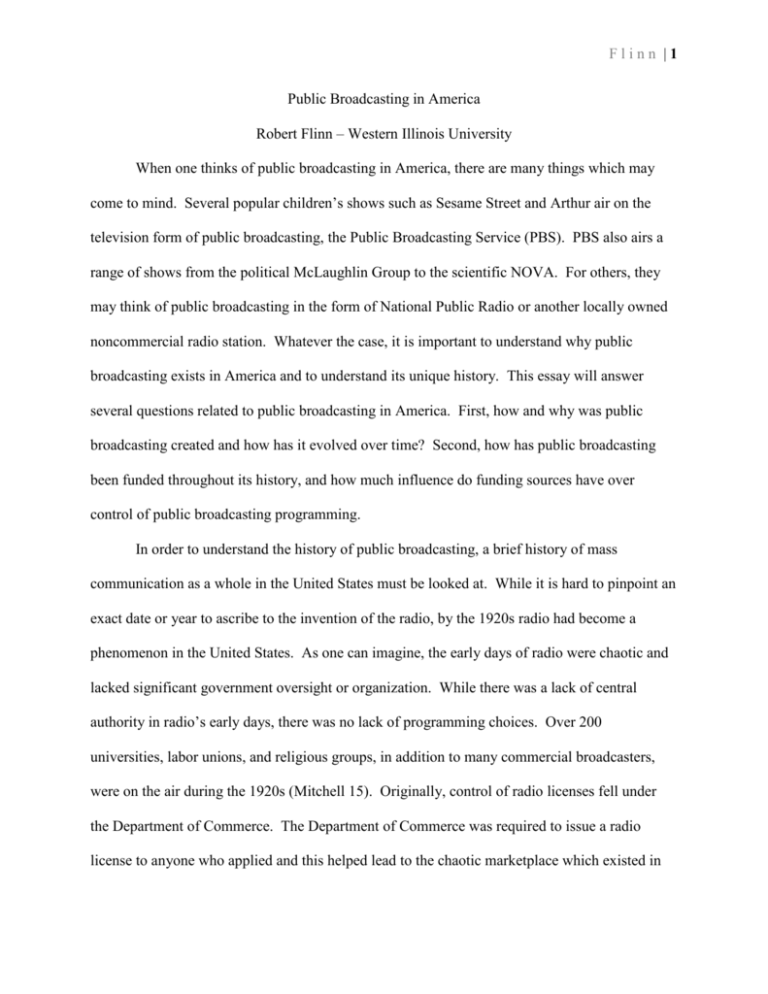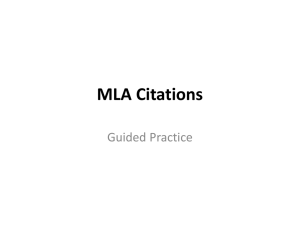Public Broadcasting in America
advertisement

Flinn |1 Public Broadcasting in America Robert Flinn – Western Illinois University When one thinks of public broadcasting in America, there are many things which may come to mind. Several popular children’s shows such as Sesame Street and Arthur air on the television form of public broadcasting, the Public Broadcasting Service (PBS). PBS also airs a range of shows from the political McLaughlin Group to the scientific NOVA. For others, they may think of public broadcasting in the form of National Public Radio or another locally owned noncommercial radio station. Whatever the case, it is important to understand why public broadcasting exists in America and to understand its unique history. This essay will answer several questions related to public broadcasting in America. First, how and why was public broadcasting created and how has it evolved over time? Second, how has public broadcasting been funded throughout its history, and how much influence do funding sources have over control of public broadcasting programming. In order to understand the history of public broadcasting, a brief history of mass communication as a whole in the United States must be looked at. While it is hard to pinpoint an exact date or year to ascribe to the invention of the radio, by the 1920s radio had become a phenomenon in the United States. As one can imagine, the early days of radio were chaotic and lacked significant government oversight or organization. While there was a lack of central authority in radio’s early days, there was no lack of programming choices. Over 200 universities, labor unions, and religious groups, in addition to many commercial broadcasters, were on the air during the 1920s (Mitchell 15). Originally, control of radio licenses fell under the Department of Commerce. The Department of Commerce was required to issue a radio license to anyone who applied and this helped lead to the chaotic marketplace which existed in Flinn |2 the early days of radio. This changed with the Radio Act of 1927 which created the Federal Radio Commission. When granting new licenses or determining whether stations would get to keep their licenses, the Federal Radio Commission typically sided with larger commercial stations over the smaller university, labor union, or religious stations. The reasoning behind this was grounded in the political wisdom of the time. For instance, Herbert Hoover, who served as Commerce Secretary during parts of the 1920s, wrote a book in 1922 entitled American Individualism. Hoover believed that commercial stations would act in the public interest more so than noncommercial stations because companies knew in the long term a well-informed, healthy society was best for business. Hoover believed companies would not intentionally deceit people because this would lead to a society incapable of making wise economic decisions which would be counterproductive to business (Hoover). While this type of logic clearly holds an optimistic view of the nature of big business, it was clearly the widely held sentiment at the time, proved by Herbert Hoover enjoying an easy election to the Presidency in 1928. This type of political thought also helps to answer a fundamental question about American Public Broadcasting: why doesn’t America have a large, influential public broadcasting service similar to that of the BBC in the United Kingdom? The BBC was created in 1927, the same year as America created the Federal Radio Commission. It seems reasonable to suspect that America would have chosen to create a public station for the same reasons its English counterparts did. However, an examination of the time period quickly reveals that a station like the BBC would have never gained enough political support to ever come to fruition in America. Flinn |3 The United States emerged from World War I as the world’s biggest economic power. As previously mentioned, the 1920s was a period of political conservatism and economic prosperity. Out of this prosperity, the advertising industry which defines American culture today came into existence. At the time, advertising was seen as a way to bridge cultural divides and bring the entire nation together. As America continued to become more industrial and less agrarian, it was important to create a sense of national unity to help support the new national economy, and the advertising industry was seen as an ideal way to help bring people closer together. Therefore, people believed commercial radio served the public interest greater than noncommercial radio, which people saw as serving special, more localized, interests (Engelman 38). In radio’s early days, there was no perceived need of public broadcasting in the United States. The stages of radio development before World War II can be summarized as three parts. First, there was widespread enthusiasm for radio immediately after its invention. Second, this enthusiasm created a chaotic marketplace in which any individual or company could apply for and receive a radio license. Third, the government created an environment which favored corporate monopolies on radio stations largely as a result of the political wisdom of the time period. Even the Great Depression did not change people’s views of public radio, and the acceptance by the population to accept commercial dominance over radio remains relatively true to this day. There were some pioneers in the following World War II who challenged this conventional thought. A pacifist named Lewis Hill and a group of likeminded people had an idea for a new form of radio. Their idea was to create a station outside the mainstream media which operated using funds donated by listeners. Lewis Hill refused to serve in the military during the War and instead served in the Civilian Public Service. He then briefly worked for the Flinn |4 American Civil Liberties Union following the end of the War. Hill and his group of friends feared a turn towards totalitarianism in America in the post war period and thought the mainstream commercial media could help foster a totalitarian state. In 1949 Lewis Hill received the first noncommercial radio license in U.S. history that did not go to an educational or religious institution. That same year, he launched KPFA, Pacifica Radio, in Berkeley, California. Programming on Pacifica featured commentaries and panel discussions which contained perspectives rarely heard on mainstream American airwaves. But, the content was not purely political or news related. Programming also included live music, children’s programs, and BBC recordings. Pacifica’s launch was met with widespread local interest and garnered national press attention. However, funding the station was proving more difficult than the founders envisioned. After one year, Pacifica had only 300 people donating money and was in considerable debt. In order to save the station, Pacifica turned to outside support. Support came in the form of a grant from the Ford Foundation. Established in 1936 by the son of the founder of the Ford Motor Company, the Ford Foundation provides grants “for scientific, educational and charitable purposes, all for the public welfare” (Ford Foundation). This grant allowed Pacifica to stay on the air and create a business model capable of generating the funds needed to remain broadcasting. The decision to accept money from the Ford Foundation was met with some internal criticism. Some believed that private philanthropies linked to the business world threatened to create an environment where companies would be able to exert control over programming decisions at the station (Engelman 51). Despite these fears, Pacifica was able to remain an independent voice through the 1950s and continued airing a wide variety of programming and political views from across the entire political spectrum. Flinn |5 Pacifica remained this way until founder Lewis Hill’s untimely death in 1957 at the age of 38. As a combination of the loss of its strong, principled leader, and of the rapidly changing political environment in the Berkeley area the nature of Pacifica Radio began to change. After successfully expanding to other cities during the late 50s and early 60s, Pacifica began to serve a specific population rather than appealing to a broad range of people by offering diverse programs. Pacifica became associated with the anti-Vietnam movement and civil rights movement during the 1960s. Pacifica began to be viewed as a channel of leftist rage and expression and was no longer an objective voice. This devolution prevented Pacifica from further growth and possibly competing with the large corporate radio networks (Engelman 8082). Pacifica’s early days contributed greatly to the current system of public broadcasting in America by creating a framework for how a public radio station should operate. KPFA in Berkeley has broadcasted continuously since its launch in 1949 and still broadcasts to this day. There are also several Pacifica Radio affiliates that continue to broadcast, including 106.3 FM in Macomb, Illinois (Pacifica Network). A different form of public radio also exists in the United States and it is this type of public radio that people typically think of when hearing the term. National Public Radio (NPR) was created as a result of the 1967 Public Broadcasting Act. National Public Radio was created with some of the same goals as Pacifica Radio, but NPR can trace its origin to a separate radio movement. Some of the earliest stations to receive licenses from the FCC were educational stations. These were stations typically owned and operated by universities and aired local content. This type of station suffered from issues such as weak signals, poor financing, and no cohesion among similar stations. In order to become more prevalent some people within educational radio lobbied for a more cohesive national network of educational radio stations. Flinn |6 Around this period, the Carnegie Corporation of New York, a foundation to “promote the diffusion of knowledge and understanding,” (Carnegie Corporation) issued a report to the federal government about the importance of public broadcasting. The President at the time, Lyndon Johnson, considered public broadcasting to be part of his ambitious great society agenda. In regards to public broadcasting, he said, “the public interest will be fully served through the public airwaves” (Barsamian 23). The Carnegie report suggested that these public broadcasting stations be paid for from an excise tax being levied on the sale of new televisions. The revenue from this tax would be placed into a trust fund to ensure independence from government control. This recommendation was not included in the final piece of legislation as congress preferred that the issue of funding would be left up to congressional appropriations. In order to gain an accurate understanding of why the Public Broadcasting Act of 1967 was passed, one needs to look no further than the text of the actual legislation: It is in the public interest to encourage the growth and development of public radio and television broadcasting, including the use of such media for instruction, educational, and cultural purposes; it furthers the general welfare to encourage public telecommunications services that will be responsive to the interests of the people both in particular localities and throughout the United States, which will constitute an expression of diversity and excellence, and which will constitute a source of alternative telecommunications services for all the citizens of the Nation; it is in the public interest to encourage the development of programming that involves creative risks and that addresses the needs of unserved and underserved audiences, particularly children and minorities; it is necessary and Flinn |7 appropriate for the Federal Government to complement, assist, and support a national policy that will most effectively make public telecommunications services available to the citizens of the United States. (Public Broadcasting Act of 1967). The Act also established the Corporation for Public Broadcasting. This is a non-profit, nongovernmental entity comprised of a 15 member board. The board is appointed by the President, and approved by the Senate. The board cannot contain more than 8 members of one political party. The Corporation was set up to make funding decisions for public broadcasting, but not to produce or distribute programming. Separate agencies were created for those purposes, and those two agencies were National Public Radio for radio and the Public Broadcasting Service (PBS) for television (Engelman 88). National Public Radio’s first Director of Programming was William Siemering. Siemering was station manager for an educational station in upstate New York and was responsible for drafting the mission statement for NPR. The statement was: National Public Radio will serve the individual: it will promote personal growth; it will regard the individual differences among men with respect and joy rather than derision and hate; it will celebrate the human experience as infinitely varied rather than vacuous and banal; it will encourage a sense of active constructive participation, rather than apathetic helplessness. (Siemering 248) On April 1, 1971, 90 stations in 32 states broadcasted National Public Radio for the first time. The first piece broadcasted on NPR was a tape of concerts by the Los Angeles Philharmonic. One month later, NPR had expanded to 104 stations in 34 states and the first broadcast of the program, All Things Considered was aired. It took no time at all for NPR to Flinn |8 receive acclaim for its work, evidenced by the fact that All Things Considered won a Peabody Award in its first 18 months of existence. All Things Considered continues to be a staple of public radio, consistently ranking in the top five most listened to radio programs in America regardless of commercial status or genre (NPR audience high). The praise for NPR continued into the later part of the 1970s. The follow up to the Carnegie Report was published in 1977 and praised NPR. The report complemented NPR on preserving “uniquely American art forms: jazz, blues, and bluegrass.” The report also commended NPR for having a strong journalistic voice and especially noted the accomplishments of the program All Things Considered (Carnegie Commission 1979 p. 54). Despite positive reception, NPR would become the target of funding cuts under the Presidential Administration of Ronald Reagan. The Reagan Administration was successful in their goal of cutting funding to the Corporation for Public Broadcasting. This caused NPR to become more reliant on corporate underwriting. Corporations agreed to give money to NPR because they were attracted to NPR’s affluent audiences. Corporate contributions to NPR went from $2.7M in 1983 to $10.6M in 1988 (Starr 43). As with Pacifica Radio before, once corporate money began coming to NPR in greater amounts concern within NPR arose about maintaining the network’s integrity. In 1989, NPR board member Richard Salant publically expressed concern over the way underwriting affected news content. Salant was concerned that financially hard-pressed NPR would choose to cover stories based on availability of fundraising dollars from major corporations and not accurately report the news. The NPR President at the time, Douglas Bennet, disagreed with this claim. He noted that NPR editors submitted fundraising applications based on what they wished to cover. He insisted NPR did not “shop” Flinn |9 stories to corporations and let them decide which stories to run in exchange for a donation. Nevertheless, Salant resigned in protest and the NPR community was fractured (Engelman 104). Concerned about the direction of NPR, sociologist Charlotte Ryan conducted a formal study of NPR to determine if the network was truly caving to corporate interests or if NPR remained true to its ideological mission despite the new sources of funding. Ryan studied 2,296 stories featured on NPR over a four month period. These 2,296 stories featured 5,507 quoted sources. She found that 96% of regular commentators were white, and 79% were male. Only 7% were public interest advocators and only 15% were citizens (Starr 43). Despite a lack of diversity on its programs and its move away from its founding principles, there were positives to be found in the change of direction at NPR. For example, the corporate underwriting dollars helped NPR expand and become a more visible and influential part of the national press corps. While there were some positives at NPR at the time, there was also increasing political pressure against it. The Heritage Foundation, a conservative think tank, issued a report stating that it was unlikely that NPR would be critical of Congress, since that is where NPR receives its funding from. There was also a more general movement within American conservatism to accuse NPR of a vague, “liberal bias” (Engelman 110). The battle over NPR’s funding would not get any easier in the 1990s. Following their election to the House in 1994, the Republican congressional majority led by Speaker Newt Gingrich vowed to completely abolish funding for the Corporation for Public Broadcasting. While it would be reasonable to assume the NPR community would be upset about this proposed cut, it was met with less resistance than one would imagine. This is because there was a growing movement within the NPR community to rely less on federal funding and more on other sources. Many within NPR wanted the network to become more of a mainstream F l i n n | 10 news and entertainment source and move away from its founding ideological mission. In spite of some in NPR favoring less federal money for the network, there was mostly agreement that a complete zeroing out of federal dollars for NPR would likely put the network on the brink of extinction. The President of NPR at this time, Delano Lewis, was successful in putting pressure on the Republican congress to not totally cancel all funding for the network. He was able to do this by noting the fact that NPR had a weekly audience of over 20 million listeners, and as NPR listeners tended to be older and better educated, they were also much more likely to vote than the general population. Lewis was able to convince Republican congressmen that voting to remove NPR from the airwaves would not play well with these people and they could receive a severe political backlash if the cuts were enacted. The Republicans compromised by agreeing to only cut 25% of the Corporation for Public Broadcasting’s appropriation and only on a temporary basis. By the year 2000, the Corporation’s funding would be fully restored (Mitchell 172-174). In conclusion, the history of public broadcasting in the United States is rich and complex. Different sources of funding have certainly had an effect on the programming offered by public broadcasters, but it is hard to determine if this has been good or bad for all parties involved. The biggest challenge for public broadcasting in the future is unlikely to be adequately funding the stations, but rather increased competition from new digital technology like the internet. The future of public broadcasting is uncertain, but public broadcasting has certainly had an effect on American media and politics.



